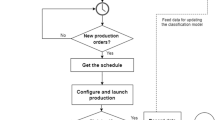Abstract
This paper presents an algorithm for scheduling the disassembly of discrete parts characterized by a well-defined product structure in an uncertain environment. Gupta and Taleb (Int J Prod Res 32(8):1857–1866, 1994) defined an algorithm, the reverse MRP, that can be applied to a product structure in which there is a certain demand for components and a need to know the number of products to disassemble in order to fulfill the demand for said components. Although they considered deterministic data, real information about the demand of used components is often ambiguous, vague or imprecise. To address this fact, we have re-formulated the reverse MRP algorithm using a fuzzy logic approach, incorporating imprecision and subjectivity into the model formulation and solution process. An extensive experimental framework is presented to illustrate the performance of the algorithm.
Similar content being viewed by others
References
Taleb KN, Gupta SM (1997) Disassembly of multiple product structures. Comput Ind Eng 32:949–961
Kim H-J, Lee D-H, Xirouchakis P, Züst, R (2003) Disassembly scheduling with multiple product types. Annals of CIRP 52:403–406
Neuendorf KP, Lee D-H, Kiritsis D, Xirouchakis P (2001) Disassembly scheduling with parts commonality using Petri nets with timestamp. Fund Inform 47:295–306
Gupta SM, Taleb KN (1994) Scheduling disassembly. Int J Prod Res 32(8):1857–1866
Lambert AJD (1995) Optimal disassembly of complex products. Int J Prod Res 35(9):2509–2523
Pnueli Y, Zussman E (1997) Evaluating the end-of-life value of a product and improving it by redesign. Int J Prod Res 35(4):921–942
Moore KE, Gungor A, Gupta SM (1998) A Petri net approach to disassembly process planning. Comput Ind Eng 35:165–168
Lambert AJD, Gupta SM (2005) Context of end-of-life disassembly. In: Disassembly Modeling for Assembly, Maintenance, Reuse, and Recycling, edited by CRC Press, 23
Taleb KN, Gupta SM, Brennan L (1997) Disassembly of complex product structures with parts and materials commonality. Prod Plan Control 8(3):225–269
Murthy DNP, Ma L (1991) MRP with uncertainty: A review and some extensions. Int J Prod Econ 25:51–64
Lee D-H, Kang J-G, Xirouchakis P (2001) Disassembly planning and scheduling: review and further research. J Eng Manuf 215 (5):695–710
Lee, D-H, Xirouchakis P, Züst R (2002) Disassembly scheduling with capacity constrains. Annals of the CIRP 51:387–390
Lee D-H, Kim H-J, Xirouchakis P (2004) Disassembly scheduling: An integer programming approach. J Eng Manuf 218(10):1357–1372
Lee D-H, Xirouchakis P (2004) A two-stage heuristic for disassembly scheduling with assembly product structure. J Oper Res Soc 55:287–297
Guiffrida AL, Nagi R (1998) Fuzzy set theory applications in production management research: A literature survey. J Intell Manuf 9(1):39–56
Karwowski W, Evans GW (1986) Fuzzy concepts in production management research: a review. Int J Prod Res 24(1):129–147
Davis T (1993) Effective supply chain management. Sloan Manage Rev 34(4):35–46
Mula J, Poler R, García-Sabater JP, Lario FC (2006) Models for production planning under uncertainty: A review. Int J Prod Econ 103:271–285
Petrovic D, Roy R, Petrovic R (1999) Supply chain modelling using fuzzy sets. Int J Prod Econ 59:443–453
De Bodt MA, van Wassenhove LN (1983) Cost increases due to demand uncertainty in MRP lot sizing. Decis Sci 14:345–362
Wacker JG (1985) A theory of material requeriment planning (MRP): An empirical methodology to reduce uncertainty in MRP systems. Int J Prod Res 23:807–824
Kerr RM, Walker RN (1989) A job shop scheduling system based on fuzzy arithmetic. Third International Conference on Expert Systems and the Leading Edge, South Carolina, USA, 433–450
Lee YY, Kramer BA, Hwang CL (1991) A comparative study of three lot-sizing methods for the case of fuzzy demand. Int J Oper Prod Manage 11:72–80
Grabot B, Geneste L, Reynoso-Castillo G, Vérot S (2005) Integration of uncertain and imprecise orders in the MRP method. J Intell Manuf 16:215–234
Watanabe T (1990) Job-shop scheduling using fuzzy logic in a computer integrated manufacturing environment. Fifth International Conference on Systems Research, Informatics and Cybernetics, August 6–12, Germany: Baden–Baden
Inuiguchi M, Sakawa M, Kume Y (1994) The usefulness of possibilistic programming in production planning problems. Int J Prod Econ 33:45–52
Fargier H, Thierry C (2000) The use of possibilistic decision theory in manufacturing planning and control. In: R. Slowinski and M. Hapke (eds.) Fuzzy Master Production Scheduling in Scheduling under Fuzziness. Springer-Verlag, Berlin, pp 45–59
Mula J, Poler R, García-Sabater JP (2007) Material requirement planning with fuzzy constraints and fuzzy coefficients. Fuzzy Sets Syst 158:783–793
Ho C-Y (1989) Evaluating the impact of operating environments on MRP system nervousness. Int J Prod Res 27(7):1115–1135
Grabot B, Geneste L (1998) Management of imprecision and uncertainty for production activity control. J Intell Manuf 9:431–446
Geneste L, Grabot B, Letouzey A (2003) Scheduling uncertain orders in the customer-subcontractor context. Eur J Oper Res 147(2):297–311
Dubois D, Prade H (1989) Processing fuzzy temporal knowledge. IEEE Trans Syst Man Cybern 19(4):729–744
Gupta A, Maranas CD (2003) Managing demand uncertainty in supply chain planning. Comput Chem Eng 27:1219–1227
Barba-Gutiérrez Y, Adenso-Diaz B, Gupta SM (2008) Lot-sizing in reverse MRP for scheduling disassembly. Int J Prod Econ 112(2):741–751
Mula J, Poler R, Garcia JP (2006) MRP with flexible constraints: A fuzzy mathematical programming approach. Fuzzy Set System 157:74–97
Author information
Authors and Affiliations
Corresponding author
Rights and permissions
About this article
Cite this article
Barba-Gutiérrez, Y., Adenso-Díaz, B. Reverse MRP under uncertain and imprecise demand. Int J Adv Manuf Technol 40, 413–424 (2009). https://doi.org/10.1007/s00170-007-1351-y
Received:
Accepted:
Published:
Issue Date:
DOI: https://doi.org/10.1007/s00170-007-1351-y




